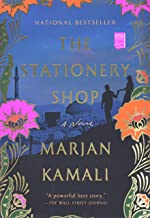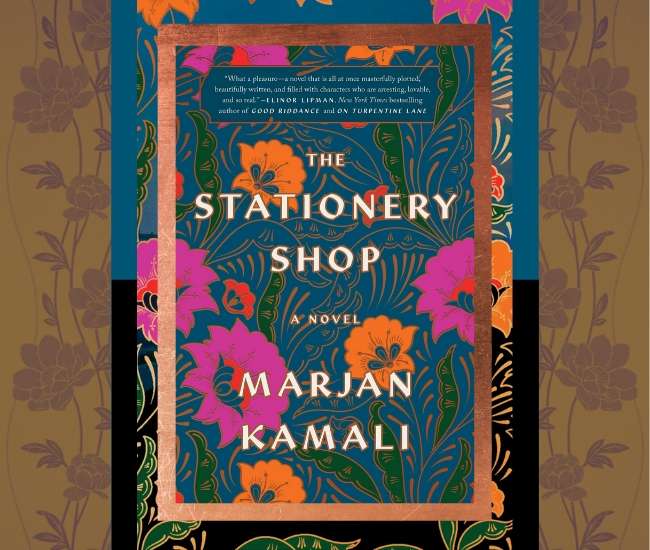The Stationery Shop by Marjan Kamali
In The Stationery Shop (Gallery Books), author Marjan Kamali tells a love story gone wrong among political unrest in Iran 1950s.
We begin in 2013 in Massachusetts when an older woman, Roya, is visiting an old man in a nursing home. Then we go back in time to the 1950s where young Roya finds solace in Mr. Fakhri’s quaint shop full of writing materials and books. She meets a handsome political activist, Bahman, and they fall in love. They are separated for a time for safety reasons and communicate via letters passed back and forth through Mr. Fakhri’s books. Through their messages, they make a special plan to meet in the square, but protests are erupting, something goes horribly wrong and Roya is devastated, crushed with disappointment and despair. She and her younger sister, left with little hope for a future in Iran, leave their country to attend college in the United States. Both fall for American men and they stay in America and marry.
Roya’s passion for literacy and young love are taken away with the tragic happenings in Iran, but she creates a new life in a town outside of Boston with Walter, a good man. After the devastating loss of a child, her life with Walter seems like it is headed nowhere until another baby shines light. But Roya’s happiness is continually clouded by the loss of her teenage dream, the handsome activist, Bahman, back in Tehran.
The story ends with an unpredictable twist that brings understanding to all the characters and their relationships. Kamali closes the loop in a satisfying way that mends broken hearts and revisits the past with new eyes.
The Stationery Shop is a beautiful and emotional story that would make a great read for lovers of historical fiction or as a book club pick.
Q & A With Marjan Kamali
Q: History, romance and incredible characters are the perfect combination for me. I was obsessed with reading this book once I started, and I cried on and off right up until the last page. How did you come up with the idea for this derailed love story?
A: Thank you; I am so glad the story resonated with you. And you are not alone in having cried! The inspiration for this story came from a very special experience I had when I was promoting my first book, Together Tea. I was asked to read at an assisted living center, and after the reading, we all sat down to a wonderful Persian lunch organized by the center (there is a lot of food in both my books!). An elderly man in a wheelchair at our table kept saying how he’d met the prince of Spain and traveled with Charles De Gaulle. Others weren’t interested in hearing his repetitions. But before I left, I asked what his name was and was surprised that it was an Iranian name. Weeks later when I visited my parents, I told them about this elderly man. When I said his name, my father said, “He was one of our most decorated foreign dignitaries. He met the prince of Spain. He traveled with Charles de Gaulle.” I was stunned. That night I kept thinking about what it meant to be an elderly person in an assisted living center with a past that no one believed. Or, a past people believed but just didn’t care about. I knew then that I had the kernel for my next book. I started with just the image of an elderly man in a wheelchair. But then I added the story of a great lost love and letters passed in books in a stationery shop.
Q: The story begins at the end, when a woman, escorted by her husband, gets dropped off at a nursing home outside of Boston, to visit her first love from her teenage years growing up in Iran. Did you write that ending first and then come up with what came before, or did you add that part to the beginning of the book once you finished the story?
A: I wrote that scene first. I knew I wanted to start the novel with the reader knowing that this is a tale not just of first love, but of lost love. It was very important to me to frame the story with Roya and Bahman reuniting when they are both 77 after they have spent sixty years apart. And to then go back in time to when they are 17 and first meet.
Q: The letters between Roya and Bahman leading up to their meeting in the square were suspicious; I got the sense there was something not right but couldn’t put my finger on it. The revealing letter at the end, which told the whole story, was the perfect way to tie up all loose ends and answer all the questions. Where did the idea of exchanging letters in books come from?
A: My dad told me about a stationery shop in Tehran that sold books from all over the world. He said high school kids would hide love notes in between the pages of books and have the stationery shop owner pass on their messages to their beloveds in this way. I was intrigued by that gesture and wanted to include it in my book. And then I added the letters from Bahman to Roya, including the revealing letter at the end.
Q: The stationery shop is where Roya and Brahman’s love story blossoms and the nursing home is where it concludes. Both locations were so vivid in my mind. How did you create settings the reader can become absorbed in with your language?
A: Setting is so important to any novel, and I am a strong believer in creating not just a sense of place but a true atmosphere. For the stationery shop scenes, I asked my father to share his memories of a similar stationery shop in Tehran. I wanted to create not just the layout of the stationery shop but its mood. I had to dive in and imagine myself there, in a near-perfect sanctuary, using all my senses. As for the nursing home, I drew on my own experience of having visited a senior center in Massachusetts on which the Duxton Senior Center is based and also used my imagination a lot!
Q: The love between Roya and Bahman is powerful, yet family tradition and political unrest both interfered with what they hoped was their destiny. How did you research Iranian customs and government activity in 1950s Iran?
A: To prepare myself for writing about 1950s Iran, I read books about the coup d’état of 1953 and immersed myself in autobiographical accounts. I pored over newspaper articles with timelines of what happened down to the hour on August 19, 1953. I also interviewed family members and friends of family. My father helped me by sharing period details such as what kinds of pastries were served in Tehran cafes in 1953 or what kind of movies were popular. A few cool facts I discovered: many high school kids in Tehran at the time were learning how to dance the tango and the waltz. They were watching Italian films at Tehran cinemas and arguing about democracy, communism and the parliamentary system. There was a true feeling of the country being on the cusp of a great new beginning.
Q: The chapters about Mr. Fakhri as a young man were a surprise and a joy; they gave me crucial information and insight, providing him special importance in the story, which ultimately caused my heart to break even more. How did you come up with the characters of Mr. Fakhri, his first love, and the story structure … feeding us information, little by little to create the full picture?
A: When I first started writing, Mr. Fakhri was just this benevolent stationery shop owner who was calm and wise and a mentor to Bahman. But as I wrote, his past bubbled up. To be honest, the twists and turns that developed even took me by surprise! It was like trying to put together a jigsaw puzzle. I had the pieces in the different characters and their past but I had to find a way to put them all together. Figuring out how these pieces fit to create a greater whole was intense and emotionally demanding but ultimately so very rewarding.
Q: Do you have a new book in the works and can you tell us about it?
A: Yes, I am just at the beginning stages of a new book. I think you carry a book in your heart and mind for a while before starting to actually write anything. So right now I am at that dreamy stage where the characters are just beginning to bubble up. I have a sense of the mood and the atmosphere and the theme. Later, it will all (hopefully!) form a story. I’m starting that jigsaw puzzle again!
Q: I love how you use Persian food in your book to create a feeling of home. Is there a favorite (easy) recipe you could share?
A: I get asked about recipes a lot! In fact, many readers have told me they are trying their hand at making the dishes featured in the book. So here are some links to some of the dishes in the book:
- Jeweled Rice — this is served at Roya’s engagement party in Chapter 8
- Persian Cantaloupe Drink — this can be served with or without alcohol. Roya and the guests drink it at the tango party in Chapter 9
- Cinnamon Pastries — Roya and Bahman share these in the Tehran cafes in 1953
- Yellow Split Pea Stew — Roya makes this for Walter in Chapter 19, but she uses chicken instead of beef, as readers know! You can also substitute tofu for the meat and/or skip the meat altogether
- Ghormeh Sabzi Stew — Walter proposes over this dish in Chapter 20
I hope you enjoy!
RELATED POSTS
A Teen Girl’s Journey: Learning to Love Iran Through Its Food
“Song of a Captive Bird” is a Stunning Account of Famed Iranian Poet Forugh Farrokhzad’s Life
Jennifer Blankfein’s Book Nation Review of Refuge by Dina Nayari
https://booktrib.com/wp-content/uploads/2020/03/marjan-kamali-crop300.jpg
.








